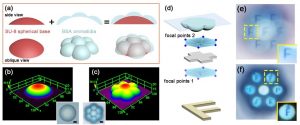Have you not always wondered how dragonflies reorient themselves during their flight when they chase their prey or how cats see even better than us at night? In reality, the process of vision and the chemistry behind it varies completely depending on the species. Through thousands of years of evolution, the compound eyes of arthropods have become an unusual visual system that features a series of unique advantages, including a wide field of view (FOV), small imaging distortion, large depth of field, and high sensitivity to moving objects.
Recently, the promising properties of compound eyes have provoked considerable research interest in developing artificial compound eyes for cutting-edge applications in robotics, medical endoscopes, surveillance devices, and military reconnaissance. However, both natural and artificial compound eyes are composed of ommatidia with fixed focal lengths, and are thus incapable of variable-focus imaging.
In a recent paper published in Advanced Functional Materials, Prof. Hong-Bo Sun from Tsinghua University and Prof. Yong-Lai Zhang from Jilin University, inspired by the tunable crystalline lens of human eyes, fabricated smart stimuli-responsive compound eyes with combined advantages from both insect compound eyes and human eyes.
This process is based on the bovine serum album (BSA) protein via femtosecond laser direct writing. In this manner, the authors obtained smart compound eyes with a large FOV and varifocal capability simultaneously.
They found that by varying the pH of the surrounding environment, the BSA-based compound eyes achieved controllable and reversible swelling and shrinking, leading to a tunable FOV and focal length. In addition to direct prototyping of entire compound eyes, flexible integration of tunable BSA ommatidia with given micro-optical components was also realized.
BSA-based compound eyes achieved controllable and reversible swelling and shrinking, leading to a tunable FOV and focal length. In addition to direct prototyping of entire compound eyes, flexible integration of tunable BSA ommatidia with given micro-optical components was also realized.
“The smart compound eyes exhibit great potential for a broad range of applications, such as robotic vision of micro-robots, optofluidic devices with large-field monitoring, medical endoscopic diagnosis, and microscale particle image velocimetry, in which tunable imaging and large viewing-angle detection are prominent advantages,” states Prof. Sun.
It is believable that such focal tunable compound eyes may present a new perspective for tunable imaging.
In addition, considering the good biocompatibility of the BSA protein, smart compound eyes may find broad applications in biological tissue monitoring, in vivo imaging, and optofluidic chips.

















